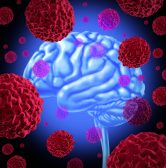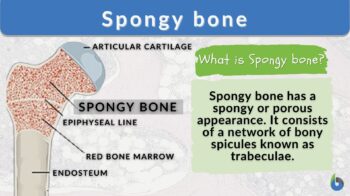
Spongy bone
n., plural: spongy bones
[ˈspʌnd͡ʒi ˈboʊn]
Definition: cancellous bone or trabecular bone
Table of Contents
Spongy bone, also known as cancellous bone or trabecular bone, is a type of bone tissue found at the ends of long bones and in the middle of other bones such as the vertebrae. It is lighter and less dense than compact bone. Spongy bone contains red bone marrow, which is responsible for producing blood cells.
Spongy Bone Definition
Spongy bone (cancellous bone or trabecular bone) is a type of bone tissue present in the human body. It is less dense than compact bone and has a spongy or porous appearance. It consists of a network of bony spicules known as trabeculae. It forms a lattice-like structure inside of a bone that not only provides support but also helps to distribute forces throughout the bone.
The bone marrow in the spongy bone produces blood cells and helps to maintain the health of the bone tissue. While all spongy bone is less dense and more flexible than compact bone, the term “soft spongy bone” is typically used to distinguish this type of bone from the spongy bone found in other locations in the body, such as the ends of long bones or the middle of flat bones.
Watch this vid about Spongy bone:
A spongy bone is an osseous tissue that fills the interior or cavity of bones with a latticework of small spicules or flat pieces of mineralized bars (trabeculae) and interstices containing bone marrow or fat. It resembles a sponge or a honeycomb with spaces containing bone marrow or fat.
This type of osseous tissue lies subjacent to the compact bone and is made distinct by its spongy structure. It is found at the ends of long bones and in the vertebrae. It has low density and strength but a high surface area that allows room for blood vessels and marrow. The outer surface layer of this tissue contains the red bone marrow where hematopoiesis takes place.
Etymology: spongy < from Latin spongia, from Greek spongiā, from spongos; bone.
Synonyms: cancellous bone, trabecular bone, spongy substance, substantia spongiosa (Latin name), spongiosa.
Compare: compact bone
Structure of Spongy Bone
Spongy bone structure and spongy bone anatomy are explained below.
Spongy bone is a porous and light bone containing several big gaps that give the impression of being honeycombed or spongy. The bone matrix or framework is composed of a 3-D latticework of bony tissue termed trabeculae aligned along stress lines. The interstices are frequently packed with bone marrow and blood vessels (arteries). (Britannica, 2023)
The spongy bone diagram is as follows:
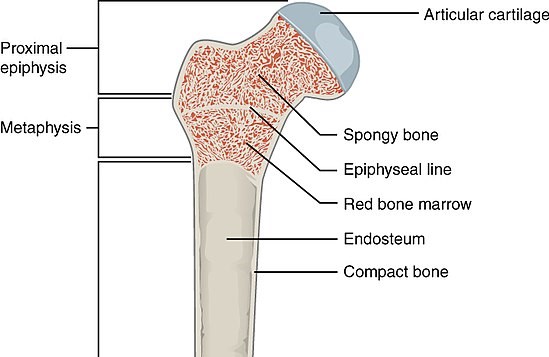 | 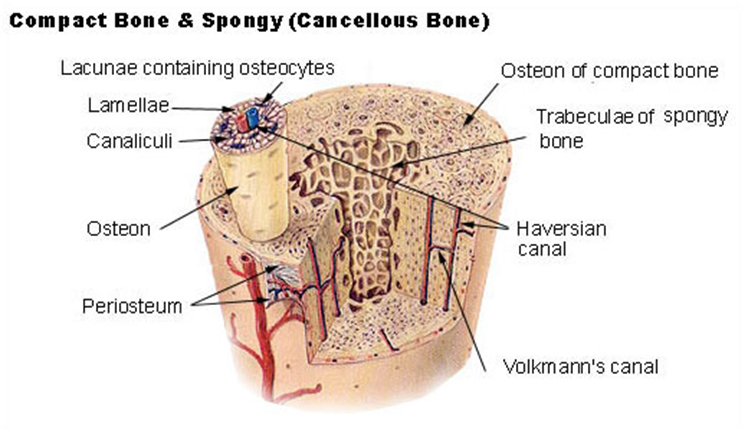 |
| Figure 1: The long bone diagram: internal structure of a human long bone. Image Credit: OpenStax College (left) and SEER. | |
What are lacunae?
In spongy bone tissue, lacunae refer to small spaces within the trabeculae that contain osteocytes.
Blood veins go through the denser, solid bone to the softer, sponge-like bone, supplying it with the components needed to produce blood cells. Blood cell-forming tissue in spongy bone is the red marrow. Osteocytes located near blood arteries can collect nutrients and expel waste via canaliculi, which are microscopic linked tubes on the surface of trabeculae.
Osteoblasts, which are bone cells that make the material that makes up the compact bone matrix, can turn soft sponge bone into mature bone cells and then into hard bone. The long bones in a human can develop through this process during embryonic life.
The Haversian canal or central canal is present in the center of each osteon of compact bone tissue, and it serves as a channel for blood vessels, nerves, and lymphatic vessels. However, unlike compact bone, the spongy bone does not possess a central canal. It is composed of thin plates and bars of bone adjacent to small, irregular cavities that house red bone marrow.
Spongy bone histology
From a histological standpoint, spongy bone is composed of thin and interconnected bony spicules referred to as trabeculae, which encase both blood vessels and marrow. (Kenhub, July 07, 2022 )
Spongy bone location
Where is spongy bone found? 20% of the human skeleton is composed of cancellous bone, which provides mechanical support as well as mobility without the load on compact bone. Compact bone functions to provide strength and protection to bones. It is present in the majority of bone structures and regions that are not susceptible to intense mechanical stress.
The human body is composed of cancellous or sponge-like bones. The human body contains two types of bones: flat bones and long bones. Spongy bone is found specifically near the articular cartilage, at the ends of long bones, pelvic bones, ribs, skull bones, and spinal vertebrae. Within flat bones such as the cranium, it is distributed throughout the bone. It is exclusively seen at the extremities of long bones like in the femur.
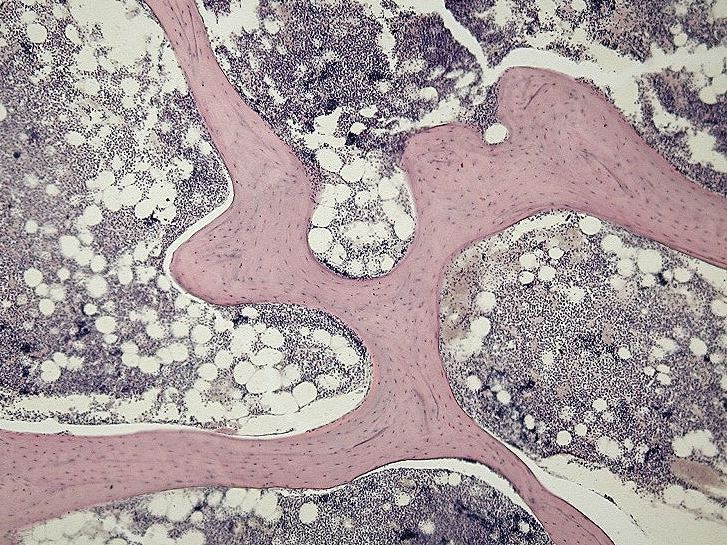
The porous structure of cancellous bone enables it to absorb sudden loads. Depending on the need for strength or flexibility, different bones have variable amounts of space within them.
Site of spongy bone in adults
Spongy bone is found at various sites in the adult skeletal system. It is located at the ends of long bones, such as the femur and humerus, and in the middle of flat bones, such as the sternum and the bones of the skull. Moreover, spongy bone is found within the vertebrae of the spinal column, as well as in the pelvis and in the bones of the hands and feet.
Cancellous bone tissue
The human body’s bones consist of various types of cells, including osteoblasts, osteocytes, and osteoclasts.
Osteoblasts are bone-forming cells. Osteocytes are the most abundant bone cells and develop from osteoblasts. In contrast, osteoclasts are bone-destroying cells, and their increased activity relative to osteoblasts can lead to osteoporosis spongy bone.
The spongy bone that is found within the ends of long bones is called cancellous tissue. Spongy or cancellous bone tissue, however, differs from compact bone tissue in that it contains bone marrow, which includes stem cells that produce red blood cells, white blood cells, and platelets. Both types of bone tissue, cancellous, and cortical, contain osteoblasts, osteocytes, and osteoclasts, which facilitate bone remodeling.
Cancellous bone density
The density (mass over volume) of compact or cortical bone differs significantly from that of cancellous or spongy bone. The density of compact bone is approximately 2000 kg/m3. The density of trabecular, cancellous, and spongy bone is 1,874 g/mm3. Many benefits are associated with having fewer thick bones in the human body. This permits flexibility. Too high bone density may also suggest the existence of osteosclerosis or osteopetrosis, which are characterized by excessive bone deposition in the long bone structure. Thus, human bones mustn’t grow too thick.
What are Spongy Bone and Compact Bone?
Compact bone and spongy bone are different. Compact bone is strong while spongy bone is soft. Compact bone makes up the diaphysis of long bones and spongy bone makes up the epiphysis of long bones.
Note it!
What is an example of a spongy bone?
Spongy/Flat bone examples: Ribs, skull, pelvis, and vertebrae.
What are bones made of?
Collagen and calcium make up bones.
Functions of Spongy Bone
Following are some of the Spongy bone functions:
- Provides structural support: Spongy bone helps to distribute forces applied to the bone, thereby providing structural support to the bone
- Produces blood cells: Spongy bone contains red bone marrow, which is responsible for producing red blood cells, white blood cells, and platelets
- Stores minerals
- Facilitates bone growth and repair
- Helps regulate bone metabolism
Storage of bone marrow
Spongy bone has bone marrow within the spaces between the trabeculae. Bone marrow produces blood cells and maintains the health of the bone tissue.
In addition to supporting the body, spongy bone also plays an important role in the production and regulation of blood cells. The spaces between the trabeculae of spongy bone contain bone marrow. Red bone marrow functions in the formation of RBCs, WBCs, and platelets. The bone marrow within spongy bone is responsible for producing approximately 50% of the body’s red blood cells and all of its platelets.
Compact bone consists of the yellow bone marrow which is stored in the medullary cavity of compact bone. Yellow bone marrow contains a large percentage of stem cells and fat. The red bone marrow in spongy bone is used in erythrocyte production.
Site of erythropoiesis
The red bone marrow inside spongy bone produces RBCs (erythropoiesis) at a rate of around 2 million per second. Because of its highly vascularized structure, spongy bone can rapidly generate new blood cells by supplying the body with lipids, glucose, amino acids, and other trace elements according to the requirement. Red blood cells that are worn out, travel back to the bone marrow, where macrophages eat them. The liver and spleen participate in this process.
Reduces the weight of the skeleton
To reduce the total weight of the skeleton and make it easier for the muscles to move the limbs, spongy bone has a lower density than compact bone.
Adds strength and flexibility to bones
Spongy bone tends to produce trabeculae along lines of stress, which provides the bone with both rigidity and strength in that particular region. Whether we walk, run, or jump, the spongy bone that is found in the joints of the body performs the function of a shock absorber for the body.
Mineral Storage
The skeleton of an individual stores 99% of the body’s calcium and 85% of the body’s phosphorous. To guarantee that the muscles and nervous system can operate normally, the mineral concentration in the blood needs to be carefully controlled. When it is necessary, the rapid mineral release into the circulation is accomplished, and hormones are frequently the agents that are responsible for mediating this activity.
Evolutionary Changes in Human Spongy Bone
The current human skeleton is distinctive because, in comparison to its overall size, it has a relatively low trabecular density. Spongy bone accounts for approximately 20% of the human skeleton.
As compared to humans, it is not surprising to learn that practically the entire skeleton of a chimpanzee is made up of porous bone. According to the results of many tests conducted on ancient human bones, early people had a larger percentage of porous bone than current humans do.
New research is carried out in which the trabecular density of the humans who lived million years ago and chimps is compared with the skeletons of current humans. The purpose of this comparison is to acquire a clearer grasp of the relevance of this outcome. The objective of this study was to establish precisely when in human evolution trabecular bone density began to decrease.
The study’s findings imply that the recent emergence of low trabecular bone density in current humans is a new phenomenon that is most likely caused by more sedentary, inactive, and technologically reliant lives.
Note it!
What is an Osseous tissue?
Osseous tissue is also called bone tissue and is the primary type of tissue that makes up the bones of the skeletal system in humans and other vertebrates.
Take the Spongy bone – Biology Quiz!
References
- Britannica, T. E. o. E. (2023). cancellous bone. Retrieved 19 March, 2023, from https://www.britannica.com/science/cancellous-bone
- Center, N. R. (2023). Bone. Retrieved 19 March, 2023, from https://www.bones.nih.gov/health-info/bone/bone-health/what-is-bone#:~:text=Made%20mostly%20of%20collagen%2C%20bone,flexible%20enough%20to%20withstand%20stress.
- Kenhub. (2023). Spongy bone. Retrieved 19 March, 2023, from https://www.kenhub.com/en/library/anatomy/spongy-bone
- Kenhub. (July 07, 2022 ). Bone histology. Retrieved 19 March, 2023, from https://www.kenhub.com/en/library/anatomy/histology-of-bone
- Study.com. (2023). Cancellous Bone Function, Structure & Location Retrieved 19 March, 2023, from https://study.com/learn/lesson/what-is-the-function-of-spongy-bone.html
- Technologies, S. H. (2023). Compact and Spongy Bones. Retrieved 19 March, 2023, from https://unacademy.com/content/neet-ug/difference-between/compact-and-spongy-bones/#:~:text=Compact%20bone%20is%20a%20robust,the%20epiphysis%20of%20long%20bones.
©BiologyOnline.com. Content provided and moderated by Biology Online Editors.







